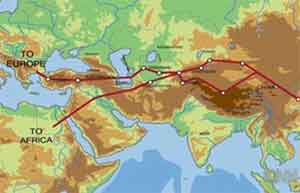The Great Silk Road (term for the first time was used in 1877 by German geographical scholar Ferdinand von Richthofen) the caravan route of the ancient times and middle ages from China to the countries of Central and Minor Asia. Historical trade routes have passed from China, Japan, India, Mongolia, Iran, Uzbekistan, Tajikistan, Azerbaijan and other countries.
This road was opened in II BC and passed through Lanchjou and extended till Dunkhuan. From there, it was divided into two parts: the north way from Turfan to Pamir and from there to steppes of Farqana and Kazakhstan. The south way passed along the Lake Lobnor, south of Takla-Makan desert to Yarkand and Pamir (southern part) and extended to Bactiria, Parfia, India and the Middle East.
Starting from I millennium of AD to the mid of the II millennium of AD the Silk Road reflects the crossing roads to Europe and Asia resembling like a network of routes. The main part of the Silk Road takes its beginning from China\'s capital Janqan (Xian). In IV BC when Alexander the Great passed Hindus River in direction of the Central Asia already the Chinese silk had an access to the Mediterranean Sea.
The sea routes also can be considered as elements necessary for trade and communication, as a part of the Silk Road.
Many important scientific and technological innovations have been carried out from East to West through the Silk Road. Gunpowder, the magnetic compass, printing press, musical instruments, silk, painted ceramic products and other innovations gradually were transferred. The west even had no idea about its existence.
Historical facts prove that the Great Silk Road had few directions and passing of many roads to the west from Asian continent. The Silk Road started from the coast of East Chinese Sea, Sinan city passes Lancjon, and extends till Donkhuan. One branch of the road enters Azerbaijan by passing from nother foothills of the Kopetdagh and southern part of the Caspian Sea. The second branch passes the north of Takla-makan desert and extends till Derbent, Shamakhi- Ganja, Batumi-Istanbul, directed to the center of the Balkan Peninsula, the center of Europe. According to other reports, the Silk Road beginning functioning 4-5 century before took the beginning from Korea. Caravans passed through China, Mongolia, Central Asia, and Azerbaijan and used to direct towards Europe through the Mediterranean and the Black Sea coasts. Despite the Silk Road conception was taken from Chinese silk being carried at this direction, already in X-XI centuries Azerbaijani silk replaced it. The first branch of the Great Silk Road passed through the territory of the South Azerbaijan it gave a great push to the development of silkworm in Derbend, Shirvan, Sheki, Beylagan, Ganja, Gabala, Tabriz, which had vast relations with this area, and caused their popularization as sericulture centers. On this route initially silk was carried out from the East to Central European countries but later spices, gold, silver, pearls, etc. were transported, too. And merchants used to carry back from the countries of Europe to East the tin, zinc, mercury, cloth fabric, etc. In this regard, in Azerbaijan, in cities like Baku, Derbent, Shamakhi, and Shirvan the caravanserais were built in order to provide comfort for merchants. But in 1492 after discovery of the American continent, the importance of this road significantly decreased. And it is connected with presence of imported goods from China and adjacent areas in the United States. After discovery of access to the sea to India, there was no need in the Great Silk Road. At the end of the XV century, with the discovery of the sea route to India the Silk Road began to lose its importance and finally in XVI century it was declined completely. During the period of existence of the Great Silk Road it played and important role in life of en-route countries and gave a great impetus to their development of their relations. The Great Silk Road connecting East and West during 2000 years began to restore its historical significance, and is capable to play a role of bridge as 1000 years ago among different cultures and civilizations. Yet at that time Azerbaijan was one of the main trade and transport junctions of this great role. The country has not lost its geographical position to this day, and was one of the initiators of the restoration of the Great Silk Road.
The base of the Great Silk Road consists of the TRACECA project prepared by the TACIS program of the European Union for the New Independent States in 1991. This project has been adopted at conference in Brussels in May 1993 with consent of the new independent states in the South Caucasus and Central Asia, by the Council of Europe. In the field of implementation of the project the linking of railways on May 13, 1996 in Sarakhs, Iran and Central Asia was an important step. Project intends to develop economic, trade relations on route Europe/ TRACECA and TransEurope directions. Realization of the project is carried out with technical and financial assistance of the Council of Europe and credits of the World Bank, European Bank for Reconstruction and Development.
The restoration of the ancient Silk Road made sea transportation an important means of transportation .between Europe and Asia, flow of transit cargo.

